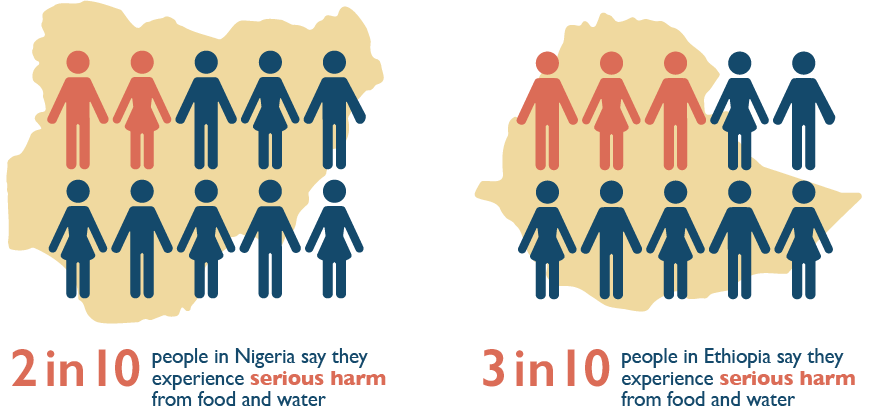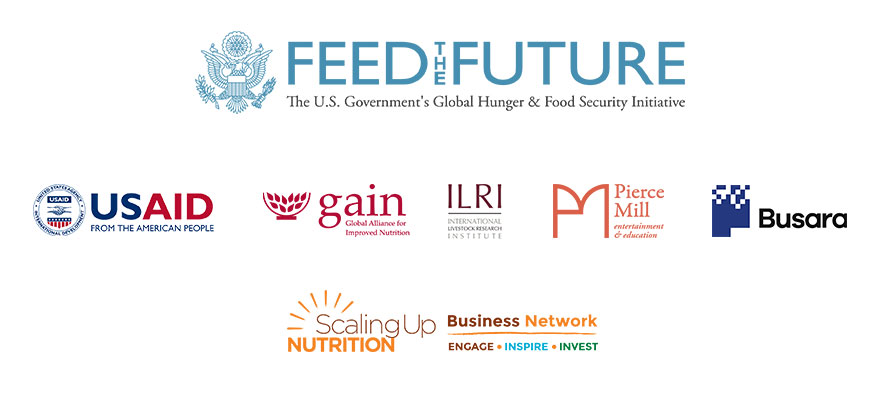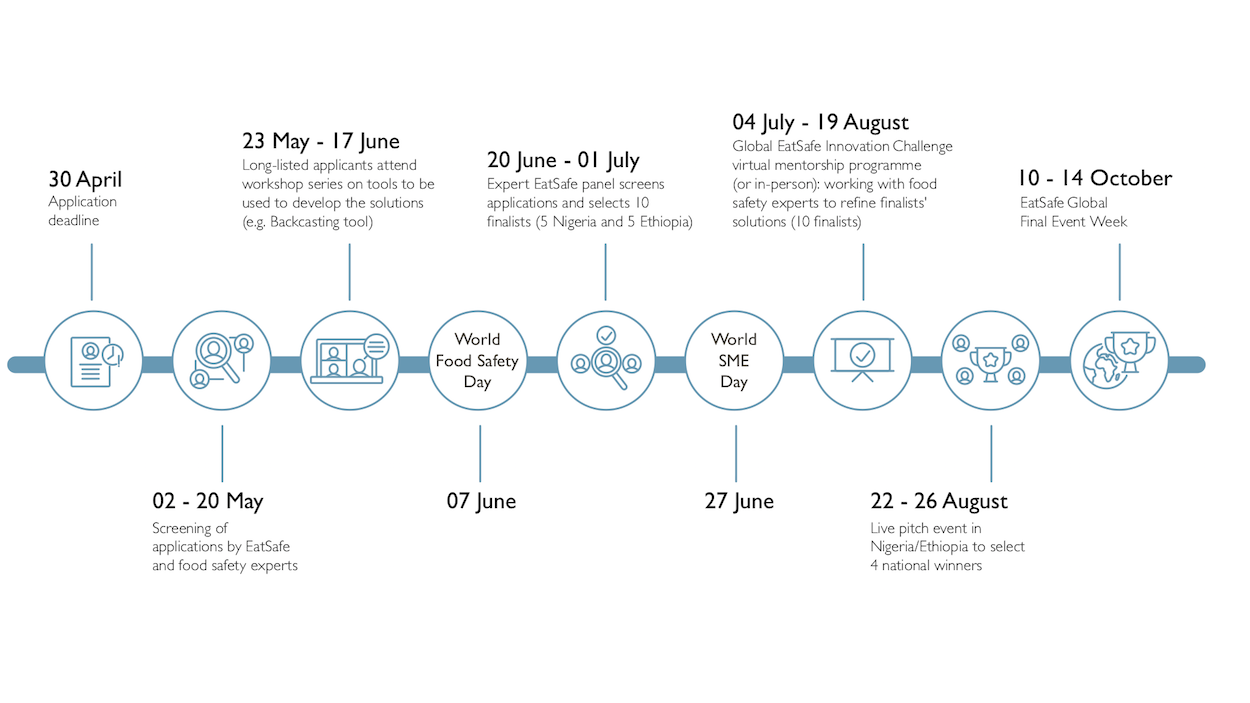EatSafe: Evidence and Action Towards Safe, Nutritious Food
On this page you will find responses to all the questions you may have about the EatSafe Innovation Challenge, as well as further information on how to apply. Improving food safety in Ethiopia and Nigeria is essential and we are glad you want to be a part of it!
What is the Challenge all about?
The EatSafe Innovation Challenge is calling all students, researchers, entrepreneurs, and innovators – passionate about food safety and/or nutrition – to share their ideas on how existing food safety innovations can be adapted and applied in traditional food markets and along value chains to resolve upstream food safety issues, which increase the amount of safer food reaching local, traditional markets. Applicants stand a chance to participate in the global EatSafe Innovation Challenge grand final which will take place at the Technical University of Denmark (DTU) in October, and where a USD 10,000 prize is up for grabs (winning concept)!

Why apply?
Participants will benefit from national and global visibility, recognition, mentorship, technical training and networking opportunities with leading industry players, investors, researchers, and academia. **Before submitting your application, please read the Terms and Conditions. By submitting your application, you confirm that you accept the Challenge privacy terms and conditions.
Title
Apply Now!
When is the challenge?
The challenge will take place between April and October 2022 and will be organized as a global initiative including national pitching events in Nigeria and Ethiopia, and a global final event in Denmark. See timeline below.
Who can apply?
This opportunity is open to students, researchers, entrepreneurs, and other innovators based in Ethiopia or Nigeria. The Challenge especially encourages women and young people working or interested in working in the field of food safety and/or nutrition to apply. Applicants must be available to travel in October 2022 and adhere to travel rules in Denmark.
What are the 7 innovation categories?
Improving food safety is a global challenge and every day innovative solutions are being developed and applied to make food safer around the world. However, not enough of these innovations have been applied in traditional food markets and further up the food chain, where they are needed the most, in Ethiopia and Nigeria. To address this gap, seven types of innovations were identified all along the food supply chain, and candidates are invited to submit concepts that modify these or present new innovations which improve food safety for use by consumers, vendors, farmers, etc.
Innovations in this category should provide a channel for consumers to receive/share food safety information or provide feedback (to businesses and with peers), as appropriate to the local context. Tools should situate food safety concepts within the context of lived social and cultural experiences. This could appear as an innovative advocacy campaign tied to a specific food safety issue. For consumer-facing apps and resources, in some cases it may be effective to include food safety (information, skill sharing, behavioral nudges, access to resources/help) within or in conjunction with topics that already hold attention, e.g. children's health, family budget, good housekeeping.
IFSS Portal Solution real-world examples linked to this category:
- Mother empowerment by distributing straightforward planetary health guidelines
- Urban youth engagement platform
Many processing activities focus primarily on transforming a raw or unrefined food into a product that meets a demand in the market. However, some processing methods can contribute to food safety risks if not managed properly. Under this category, we are looking for innovations in processing that enhance food safety. To be considered, processing innovations should provide food safety improvements that are also cost effective and still meet the existing demand (innovation that drastically changes the produce, e.g. a dried vs. a fresh product should undergo a more thorough assessment of demand and willingness to pay). To illustrate improvements, processing innovations for food safety must be able to transform a potentially unsafe food, or unsafe parts of foods, into products (food or otherwise) that are safe, or make the product less vulnerable to hazards in subsequent stages (e.g. via reducing moisture, coating, packaging, etc.). Processing innovations that capture or divert unsafe or contaminated food waste can enhance value while also reducing the risk of cross-contamination and the spread of disease; these would also mitigate equity issues by not creating a market for unsafe food for low-income groups. Processing includes preservation (i.e. drying, fermenting, etc.) stages, which may delay spoilage and enhance the profitability of food production. Processing innovations should also illustrate that they can be done in a way that the nutritional value (content, bioavailability, etc.) of the food is not compromised to make it safer.
IFSS Portal Solution real-world examples linked to this category:
Tackling food waste is a global challenge and there are many new innovations being used or tested to address the various problems. Under this category, we’re looking for food waste innovations that specifically work to enhance food safety or detect food safety risks in upcycled food for traditional markets. Food waste, either discarded/spoiled food products or the inedible/unsellable parts of raw foods, can have varying levels of “safety,” depending on the product, and may have varying propensities for upcycling depending on the type of hazard. For example, while some microbial hazards can be effectively neutralized through processing, other hazards, such as some chemicals, may not. Innovations should consider which waste stream(s) are likely to yield consistent and sufficient levels of up-cyclable waste and should also be sensitive to the ways in which hazards can and cannot be changed during processing step(s). The viability of the business model, in addition to technical viability, is key to success: if there is no demand for the upcycled product, there is no sustainability.
IFSS Portal Solution real-world examples linked to this category:
Under this category, we are looking for sensor innovations that can detect hazard(s), such as chemicals or microbials, or, alternatively, the symptoms of contamination (i.e. turgor, color, density, etc.) in LMICs. Spectral signatures (hyperspectral, multispectral, etc.) and other high-tech sensors show promise, but can be cost-prohibitive in resource-poor settings. Innovations should strike an appropriate balance between precision and field-applicability, given local constraints and the hazards of interest. With sensor technology, whose output is data, the key questions are -- what decisions are made based on the data? What problem would the data solve? Are the data used at all?). The sensor technology is often the easy part to solve; the data pipeline and use context, and who wants to pay for the data, are most often the limiting factors for adoption. Alignment with national regulations (or international, in case of export) and compatibility with existing workflows is also key to adoption.
IFSS Portal Solution real-world examples linked to this category:
Under this category, we’re looking for innovations that enhance food safety in retail or packaging of nutritious foods. For example, packaging, labels or vending machines can convey information about the product, including safety information and handling instructions. Leveraging this channel for information sharing and/or behavior change nudges is advised. Attention should be paid to not creating new food safety issues while trying to solve others (e.g. a vending machine would require thorough and frequent cleaning; in the absence of a sustainable maintenance business model, product safety could decrease). Any information communicated via packaging (including smart packages) should be appropriate to the education level and culture of the consumer population. Coating innovations (or in general approaches that add a chemical/material to a product should undergo both safety assessment and a consumer perception assessment (e.g. a coating could be perceived as "dangerous chemicals added").
IFSS Portal Solution real-world examples linked to this category:
Under this category, we are looking for innovations that enable more efficient communication between urban demand and rural supply. It is important to consider the incentive structures (including supply-demand economics) that dictate that movement of food between rural and urban sectors. If food logistics systems are responsive only to quantity, instead of quality, the transport and storage of food may be inadequate to preserve freshness and maintain appropriate levels of safety prior to reaching the market. Innovations might consider re-imagining or de-centralizing traditionally inaccessible food safety-promoting technologies, such as cold storage, refrigerated trucks, or quality control systems. Innovations might also bring safety-relevant value-addition steps closer to the production context by building up entrepreneurship opportunities and enabling urban-rural stakeholder partnerships. There can be opportunities to include traceability and transparency (e.g. consumer knows which farm the product is from) aspects, which are generally advantageous to food safety and may offer channels for consumer demand to be expressed.
IFSS Portal Solution real-world examples linked to this category:
Under this category, we are looking for innovations that increase operational efficiency of food production/processing that would add clear value to businesses and include food safety operations (e.g. built-in cleaning schedules; reminders of processing parameters such as temperature, time, concentration of cleaning agent; easy protocols to troubleshoot issues). A key aspect here is the appropriateness of the technology to the context, e.g. in terms of component acquisition/production, maintenance, and repair of the technology; training and interpretation needs; any perverse incentive (e.g. counterfeit tags); and usefulness of the data and skills/resources needed to use the data.
IFSS Portal Solution real-world examples linked to this category:
Title
How will concepts be assessed?
How will concepts be assessed?
Title
Food Safety and Nutritional Benefit
Title
Adaptability to LMICs
Title
Scalability
Title
Environmental Sensitivity
What is the process?
Applicants need to select one of the seven innovation categories and develop a compelling concept of how the innovation can be adapted. Selected applicants will attend a series of workshops on tools to use to develop the solutions, and will benefit from networking opportunities with leading industry players, investors, researchers, and academia, as well as national visibility. Selected finalists will benefit from a mentorship program with refined technical training,additional networking opportunities, national and global visibility.
Four winners from the national EatSafe Innovation Challenges (two from Ethiopia and two from Nigeria) will be announced and promoted further to their live pitch. They will go on to participate in the global EatSafe Innovation Challenge grand final in Denmark in October 2022, and the winner will be awarded a USD 10,000 prize!

Title
Apply Now!
The application deadline is 30 April 2022 at 11:00 Nigeria time / 13:00 Ethiopia time / 12:00 CEST.
Applicants will NOT be judged on the innovation’s novelty, or its maturity level/readiness: idea, prototype, gaining traction, moving to scale, mainstream. See Glossary > Solution Readiness for the definition of innovation readiness.
In the first stage, longlisted applicants will receive technical support and participate in two online-facilitated workshops to refine their idea facilitated by the IFSS portal team.
In the second stage, shortlisted applicants will participate in the Global EatSafe Innovation Challenge Virtual Mentorship Programme (July-August 2022) and will receive technical support to refine their idea before the final national competition event, including an online design workshop and one-to-one mentoring with a local food safety expert.
To be eligible to enter the Competition you must answer the following three questions truthfully.
- You are 18 years of age or over by 31 August 2022
- You reside in Nigeria or Ethiopia and (i) are not citizens of any countries of exclusion referenced in the attached Terms and Conditions and/or (ii) if applicable your business is not incorporated in any countries of exclusion referenced in the attached Terms and Conditions of the competition
- You have read, understood and agreed without reservations to the attached Terms and Conditions of the competition If you are found to have answered any of these questions falsely or misled the organisers in any way in your application then the organisers may remove you from the Competition.
GAIN reserves the right to transition any in-person event to virtual to ensure the safety of its participants. If in-person events are organized, the EatSafe Innovation Challenge will follow national COVID-19 guidelines and policies.
For further information, please contact the EatSafe Innovation Challenge support team, at eatsafeinnovationchallenge@gainhealth.org
*The EatSafe Innovation Challenge is an activity led by the EatSafe Consortium, which includes the Global Alliance for Improved Nutrition (GAIN), International Livestock Research Institute (ILRI), Pierce Mill Entertainment and Education, and Busara Center for Behavioral Economics. It is supported by Scaling Up Nutrition Business Network (SBN) and the IFSS portal.
